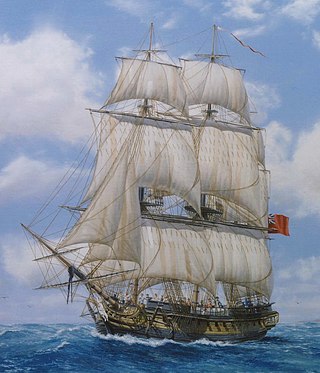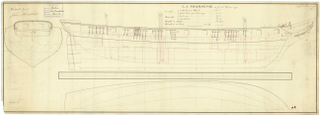Related Research Articles
Jean Bart may refer to one of the following ships of the French Navy or privateers named in honour of Jean Bart, a French naval commander and privateer.

America was a Téméraire-class 74-gun ship of the line of the French Navy. The Royal Navy captured her in 1794 at the Battle of the Glorious First of June. She then served with the British under the name HMS Impetueux until she was broken up in 1813. She became the prototype for the Royal Navy America-class ship of the line.

HMS Melampus was a Royal Navy fifth-rate frigate that served during the French Revolutionary and Napoleonic Wars. She captured numerous prizes before the British sold her to the Royal Netherlands Navy in 1815. With the Dutch, she participated in a major action at Algiers and, then, in a number of colonial punitive expeditions in the Dutch East Indies.

HMS Hind was a 28-gun sixth-rate frigate of the Royal Navy.

The Seine class was a class of four 42-gun frigates of the French Navy, designed in 1793 by Pierre-Alexandre Forfait. A fifth vessel, Furieuse, was originally ordered at Cherbourg in February 1794 to Forfait's Romaine-class design, but was instead completed to the design of the Seine class.

HMS Cleopatra was a 32-gun Amazon-class fifth-rate frigate of the Royal Navy. She had a long career, seeing service during the Fourth Anglo-Dutch War, and the French Revolutionary and Napoleonic Wars. During the latter wars she fought two notable engagements with larger French opponents. In the first engagement she was forced to surrender, but succeeded in damaging the French ship so badly that she was captured several days later, while Cleopatra was retaken. In the second she forced the surrender of a 40-gun frigate. After serving under several notable commanders she was broken up towards the end of the Napoleonic Wars.
The first HMS Epervier, sometimes spelled HMS Epervoir, was the French ex-naval brick-aviso and then privateer Épervier, launched in 1788. The British captured her in 1797 and registered her in 1798 as an 18-gun brig-sloop of the Royal Navy. The Navy never commissioned her and she was sold in 1801.

HMS Lapwing was a 28-gun Enterprise-class sixth-rate frigate of the Royal Navy.
Several French ships have borne the name Courageux, Courageaux, or Courageuse:

During the late 18th and early 19th centuries, many French privateers and letters of marque bore the name Duguay-Trouin, named for René Duguay-Trouin: René Trouin, Sieur du Gué, French privateer, admiral and Commander in the Order of Saint Louis. Between 1760 and 1810, warships of the Royal Navy captured seven different French privateers all with the name Duguay-Trouin.
Seven ships of the French Navy have borne the name Sans-Culotte in honour of the Sans-culottes:
Vautour was a French privateer launched in 1797 at Nantes that made three privateering voyages. The Royal Navy captured her in 1800 during her fourth cruise. Private owners acquired her prior to late 1801 and employed her as the whaler Vulture in the South Seas whale fisheries between 1801 and 1809. A Spanish privateer captured her in 1809.
HMS Vautour was 16-gun brig-sloop of the British Royal Navy. The navy captured her from the French on the stocks in 1809 and commissioned her in 1810. She foundered in October 1813.

HMS Swallow was an 18-gun Albatross-class brig-sloop of the British Royal Navy, launched in 1795 and sold in 1802. During her naval career she captured a number of French privateers while on the Jamaica station. After her sale she became an armed whaler sailing under a letter of marque. As a privateer she captured two French whaling vessels but then is no longer listed after 1810.
HMS Tobago was a schooner of unknown origin that the British Royal Navy purchased in 1805. In 1806 a French privateer captured her. The Royal Navy recaptured her in 1809 and took her into service as HMS Vengeur before selling her later that year.
Numerous French privateers have borne the name Vengeur ("Avenger"):
HMS Matilda was the French corvette Jacobine, which was launched in March 1794 and which the British captured in the West Indies seven months later. Matilda served in the West Indies until 1799, capturing six small privateers. In 1799 she sailed to Woolwich where she became a hospital ship. Between 1805 and 1807 she was the flagship of Rear-Admiral Henry Stanhope. She was broken up in 1810.

HMS Trompeuse was the French privateer brig Coureur that the British Royal Navy captured in 1800. She was sold for breaking up in 1811.
Battalion was launched at Whitby in 1795. She traded with the Baltic and then in 1796 became a Liverpool-based West Indiaman. A French privateer captured her in 1797 in a single ship action as Battalion was outbound on her first voyage to Jamaica. The Royal Navy quickly recaptured her. She was last listed in Lloyd's Register (LR) in 1797.
References
- Demerliac, Alain (1999). La Marine de la Révolution: Nomenclature des Navires Français de 1792 A 1799 (in French). Éditions Ancre. ISBN 2-906381-24-1.
- Norman, Charles Boswell (1887). The Corsairs of France. S. Low, Marston, Searle, & Rivington.
- Winfield, Rif (2008). British Warships in the Age of Sail 1793–1817: Design, Construction, Careers and Fates. Seaforth. ISBN 1-86176-246-1.